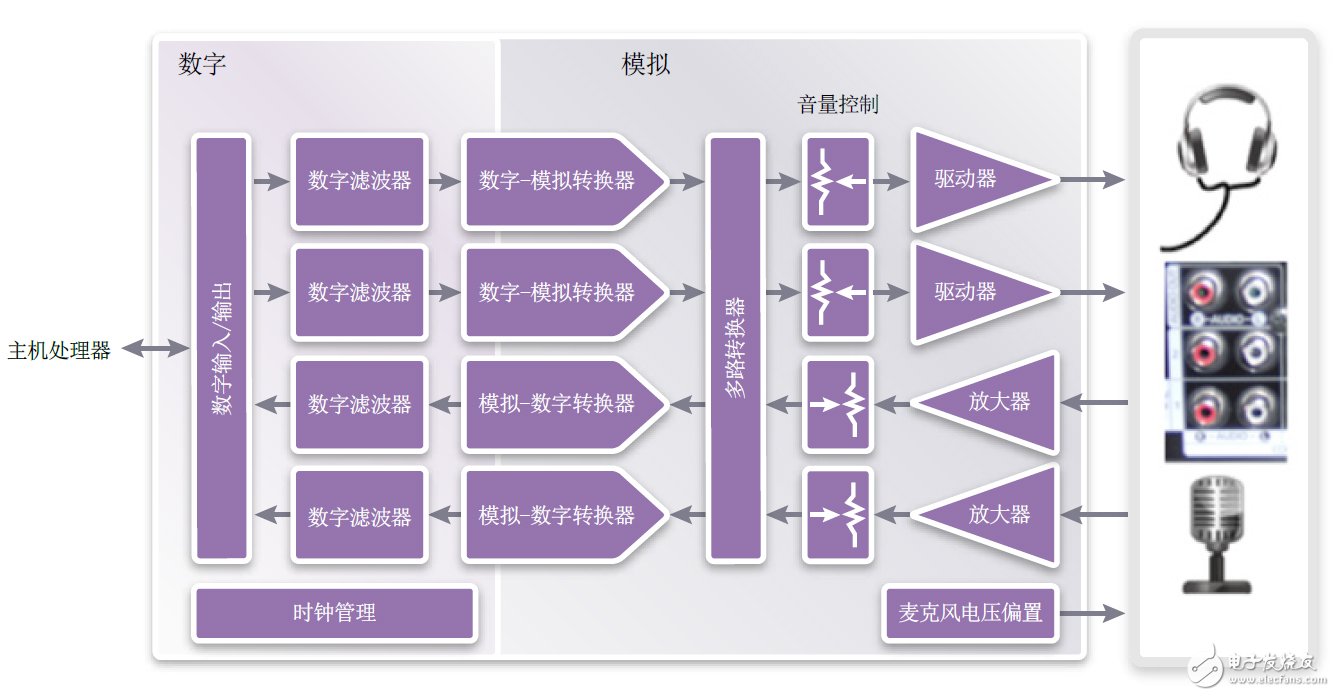Overview
Audio processing is very important for consumer electronics applications such as mobile phones and tablet computers and other mass-produced products. Area and power consumption are often the key design criteria, and the market requires high-quality high-fidelity (Hi-Fi) audio effects. Integrating silicon-proven and optimized audio IP to achieve specific audio functions helps reduce the power consumption, area, and cost of today's multimedia chip systems.
As the design gradually transitions to the 28-nanometer process technology, the challenge of integrating audio functions becomes more complicated because the analog circuits do not follow Moore's Law and will not decrease in size as the process develops. The cost of wafers using the 28-nanometer process will be much higher than the 65-nanometer or 40-nanometer process technology. Digital circuits follow Moore's Law. Although the cost of wafers has increased, its performance and density have also increased. The analog circuit used by the audio codec generally uses IO devices, so it does not use core devices like digital circuits to reduce the size. In this way, while the wafer cost increases, the inherent performance of the analog circuit has not improved, and the area has not been reduced. Therefore, a new architecture must be developed to reduce the total area. For example, an audio codec with a 65-nanometer technology and an area of ​​2.5 square millimeters needs to be reduced to 1.9 square millimeters after using 28-millimeter technology to keep the silicon cost the same. It is this 25% reduction in area that constitutes a key challenge for the audio codec of advanced process nodes.
This article examines the major system and technical challenges faced by integrating audio functions on a 28-nanometer mobile multimedia chip system, and how to address these challenges through the following technologies:
Use Moore's Law to change some functions from analog to digital;
· Flexible design, support the audio sampling rate of the chip system common reference clock;
· Make a good balance between power supply voltage reduction and performance;
· In-depth understanding of the system function division outside the chip system;
Recognizing that there are measures to minimize system costs, designers and system architects will be able to discover an effective balance between cost, functionality, and performance, enabling them to embed audio IP decoder solutions to help their SOC compete Win.
Basic knowledge of audio codec
The audio codec is mainly composed of two types of data converter modules, namely an analog-to-digital converter (ADC) for recording and a digital-to-analog converter (DAC) for playback. For stereo or multi-channel decoders, these modules are copied separately. Figure 1 is a block diagram of a typical stereo audio codec. Figure Chinese recording channels include an amplifier with volume control, which can adjust the small signal microphone and large signal cable to the input range of the analog-to-digital converter. The playback channel includes the ability to directly drive headphones or small speakers for amplification, and each channel has a volume control function. There is also a low-noise power supply that provides microphone bias.
The digital circuit is composed of multiple parts. The most important thing is the digital audio filter, which can convert the data rate to the oversampling clock of the data converter and eliminate the high frequency noise outside the audio band. Clock management is also important. It ensures that modules of different rates are synchronized with each other and supports multiple sampling rates.

Figure 1: Functional block diagram of the audio codec
Fully Automatic Washing Machine can make your clothes more clean in a very convenient way. With PCB control, different procedures can choose more ways to wash different clothes. Nowadays fully automatic washing machines are widely used in home, hotels and laundry shops.
Our well-equipped facilities and excellent quality control throughout all stages of production enable us to guarantee total customer satisfaction. Besides, we have received CE, CB, RoHS and CCC certifications.
As a result of our high quality products and outstanding customer service, we have gained a global sales network reaching America, Asia, Europe, Africa, the Middle East and other countries and regions.
If you are interested in any of our products or would like to discuss a custom order, please feel free to contact us. We are looking forward to forming successful business relationships with new clients around the world in the near future.
Fully Automatic Washing Machine
Washing Machine,Fully Automatic Washing Machine,Mini Automatic Washing Machine,Fully Automatic Washing Machine With Dryer
Ningbo Banshen Electric Appliance Co., Ltd , https://www.banshendq.com